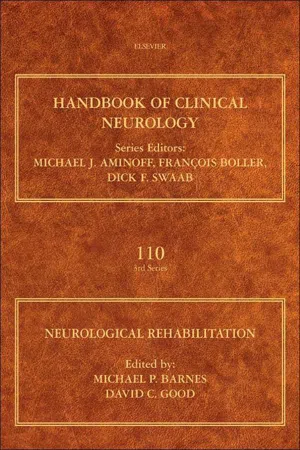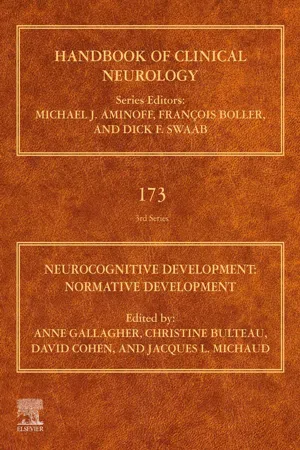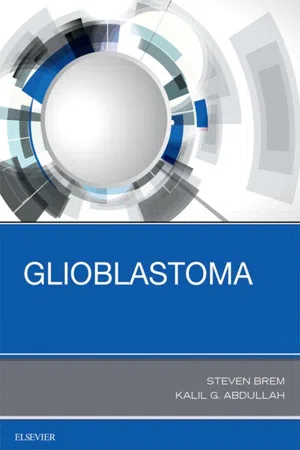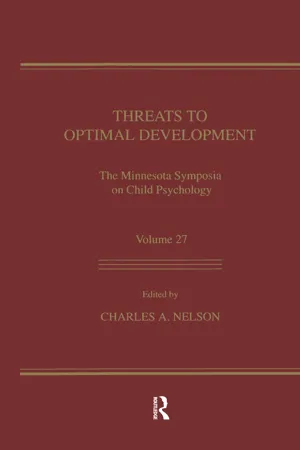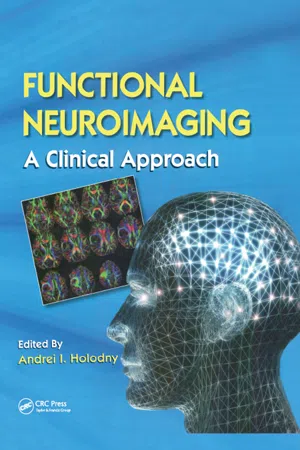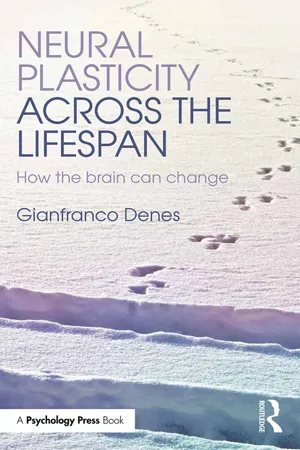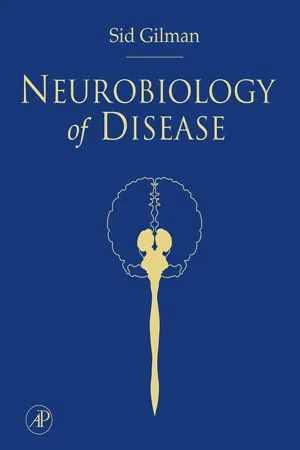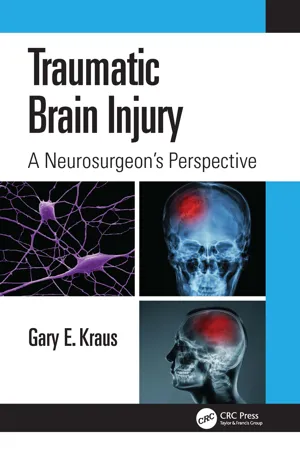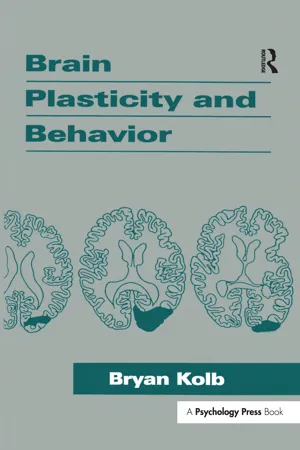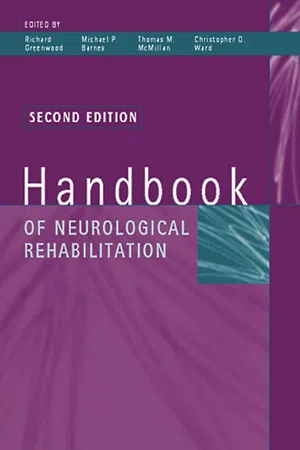Psychology
Plasticity and Functional Recovery of the Brain After Trauma
"Plasticity and Functional Recovery of the Brain After Trauma" refers to the brain's ability to reorganize and adapt following injury or damage. This process involves the formation of new neural connections and the recruitment of alternative brain regions to compensate for lost functions. Understanding plasticity and functional recovery is crucial for developing effective rehabilitation strategies for individuals who have experienced brain trauma.
Written by Perlego with AI-assistance
Related key terms
11 Key excerpts on "Plasticity and Functional Recovery of the Brain After Trauma"
- eBook - ePub
- Michael P. Barnes, David C. Good(Authors)
- 2013(Publication Date)
- Elsevier(Publisher)
Chapter 1
Neural plasticity and its contribution to functional recovery
Nikhil Sharma1 , Joseph Classen2 and Leonardo G. Cohen1 *1 Human Cortical Physiology and Stroke Neurorehabilitation Section, National Institute of Neurological Disorders and Stroke, NIH, Bethesda, MD, USA2 Department of Neurology, University of Leipzig, Leipzig, Germany* Correspondence to: Leonardo G. Cohen, M.D., Chief, Human Cortical Physiology Section and Stroke Neurorehabilitation Clinic, National Institute of Neurological Disorders and Stroke NIH, Building 10, Room 7D54 Bethesda, MD 20892, USA. Tel: +1-301-496-9782, Fax:+1-301-402-7010, E-mail: [email protected]Abstract
In this chapter we address the phenomena of neural plasticity, operationally defined as the ability of the central nervous system to adapt in response to changes in the environment or lesions. At the cellular level, we discuss basic changes in membrane excitability, synaptic plasticity as well as structural changes in dendritic and axonal anatomy that support behavioral expressions of plasticity and functional recovery. We consider the different levels at which these changes can occur and possible links with modification of cognitive strategies, recruitment of new/different neural networks, or changes in strength of such connections or specific brain areas in charge of carrying out a particular task (i.e., movement, language, vision, hearing). The study of neuroplasticity has wide-reaching implications for understanding reorganization of action and cognition in the healthy and lesioned brain.Definition
The idea that the cerebral cortex is dynamically organized was proposed in 1912, when Brown and Sherrington stimulated the motor cortex of chimpanzees and found that “a point which began by yielding primary extension may come to yield primary flexion in the latter part of the stimulation series” (Brown and Sherrington, 1912 ). In many investigations since then these phenomena have been referred to as neural plasticity. Neural plasticity can be defined as the ability of the central nervous system (CNS) to adapt in response to changes in the environment or lesions. This property of the CNS may involve modifications in overall cognitive strategies to successfully cope with new challenges (i.e., attention, behavioral compensation) (Bury and Jones, 2002 ), recruitment of new/different neural networks (Johansen-Berg et al., 2002 ; Fridman et al., 2004 ; Lotze et al., 2006 ; Heuninckx et al., 2008 ), or changes in strength of such connections or specific brain areas in charge of carrying out a particular task (i.e., movement, language, vision, hearing) (Cohen et al., 1997 ; Grefkes et al., 2008 ). At the cellular level, changes in membrane excitability, synaptic plasticity, as well as structural changes in dendritic and axonal anatomy as measured in vivo and in vitro may be demonstrated in animals and humans (Clarkson et al., 2010 ; Li et al., 2010 ). The study of neuroplasticity engages scientists from many different disciplines because of the profound implications it has for understanding the functional underpinnings of action and cognition in the healthy and lesioned brain (Dimyan and Cohen, 2010 ). Mechanistic understanding of neuroplastic changes in the process of functional recovery following brain lesions, one of the focuses of this volume, is already starting to lead to the development of more rational strategies to facilitate neurorehabilitation (Taub et al., 2002 ; Cheeran et al., 2009 - (Author)
- 2019(Publication Date)
- Elsevier(Publisher)
Neville and Bavelier, 2002 ). Brain plasticity can be studied in the context of a typical brain maturation (Dehaene et al., 2015 ), a disease process (Kirton, 2013 ), an intervention (Matusz et al., 2018 ), or an enhanced vulnerability to exaggerated injury (Johnston et al., 2002 ).We present a conceptual integrative framework that serves as a guide to investigate and correlate current theories and principles governing early brain plasticity. The framework focuses on three main domains through which synaptic plasticity and network connectivity in the developing brain can be examined (Fig. 6.1 ).Fig. 6.1 A conceptual framework for understanding early brain plasticity. When investigating neurologic and developmental disorders associated with or caused by impaired plasticity mechanisms, we encourage a careful examination of mechanisms and constraints underlying plasticity, specifying the level at which plasticity is investigated and profiling the function plasticity serves and the neurocognitive behavior under question.Mechanisms and constraints of early brain plasticity
Mechanism of neuronal plasticity
Synaptic plasticity is governed by different structural and functional mechanisms that operate over varying timescales (milliseconds to days) at the synaptic and system (connectivity) levels to accommodate for a specific function(s) of the network (reviewed in Suvrathan, 2019 and see Chapter 5 of Volume 173).It has long been postulated that synaptic plasticity is uniformly induced by the repetitive and temporally close firing of adjacent neurons. The cofiring of neurons strengthens the synaptic connection when the presynaptic neuron is excitatory (Hebbian rule), and weakens it when the presynaptic neuron is inhibitory (anti-Hebbian rule). These mechanisms form the basis for long-term potentiation (LTP) and long-term depression (LTD) models of synaptic plasticity that are implicated in associative learning and memory. Recent studies suggest than the strength of synaptic plasticity is dictated by the frequency of presynaptic firing and the order of pre- and postsynaptic firing that occurs within a precise time window. This form of plasticity mechanism called spike-timing dependent plasticity (STDP) is thought to support the refinement of sensory topographical maps, mediate associative learning, and network remodeling (Feldman, 2012 ). However, not all synapses conform to the Hebbian rule of plasticity. The strength and direction of synaptic plasticity may be influenced by the nature of presynaptic cell (excitatory vs inhibitory), the status of dendritic depolarization, the neuromodulatory actions of neurotransmitters, and the changes in sensory input (Sjöström et al., 2001- eBook - ePub
- Steven Brem, Kalil G. Abdullah(Authors)
- 2016(Publication Date)
- Elsevier(Publisher)
6In this context, the concept of the brain connectome has recently emerged. This concept captures the characteristics of spatially distributed dynamic neural processes at multiple spatial and temporal scales.8 The new science of brain connectomics is contributing to both theoretic and computational models of the brain as a complex system, and experimentally to new indices and metrics (eg, nodes, hubs, efficiency, modularity) in order to characterize and scale the functional organization of the healthy and diseased CNS.9 However, in pathology, neural plasticity is possible only if the subcortical connectivity is preserved, to allow spatial communication and temporal synchronization among large interconnected networks, according to the principle of hodotopy.10 ,11Although distinct patterns of subcortical plasticity were identified, namely unmasking of perilesional latent networks, recruitment of accessory pathways, introduction of additional relays within neuron-synaptic circuits, and involvement of parallel long-distance association pathways, the real capacity to build a new structural connectivity (so-called rewiring) leading to functional recovery have not yet been shown in humans.12 - Steven Laureys(Author)
- 2006(Publication Date)
- Elsevier Science(Publisher)
The study of whether, and particularly how, treatments can reduce impairments is thus crucial, and it is in this field that the clinical neurosciences can make a unique contribution. Plasticity in the damaged brain Despite the limited capacity of the central nervous system (CNS) to regenerate there is evidence that improvements in specific impairments do occur. Experiments in both animals and humans show that some regions in the normal adult brain, particularly the cortex, have the capacity to change structure and consequently function in response to environmental change (Schallert et al., 2000). This reorganization at the systems level is often referred to as plasticity. In addition, work in animal models has clearly demonstrated that focal damage in the adult brain can lead to a number of molecular and cellular changes in both perilesional and distant brain regions, normally seen only in the developing brain (Cramer and Chopp, 2000). This suggests that the damaged brain is more able to change structure and function in response to afferent signals. In other words it is more “plastic”. It is hypothesized that similar injury-induced changes occur in the human brain, and that targeted therapy interacts with these changes and thereby provides a means of reducing impairment in patients with focal brain damage via activity-dependent plastic change. These advances are clearly of great interest to clinicians and scientists alike. This review will concentrate on the current level of understanding of the mechanisms of recovery from motor impairment in human patients. Brain research in humans is largely performed at the systems level- eBook - ePub
Threats To Optimal Development
Integrating Biological, Psychological, and Social Risk Factors: the Minnesota Symposia on Child Psychology, Volume 27
- Charles A. Nelson, Charles A. Nelson, Charles A. Nelson(Authors)
- 2013(Publication Date)
- Routledge(Publisher)
3 Plasticity and Reorganization in Neural Injury and Neural Grafting Elizabeth M. Jansen Walter C. LowUniversity of Minnesota Medical SchoolBRAIN DEVELOPMENT AND PLASTICITYBrain development is a highly orchestrated process involving the formation and competitive elimination of connections between nerve cells. The intricacies of this process during normal development are clearly outlined by Huttenlocher (this volume). The establishment of appropriate connections is exquisitely vulnerable during critical periods of development. Traumatic insults during these periods can lead to permanent and devastating consequences and are clearly threats to optimal development. Yet, even in the face of apparently massive lesions, the nervous system often displays a remarkable capacity for reorganization.The cerebral cortex, for example, is capable of tremendous reorganization. This has been demonstrated repeatedly under different conditions in human and animal studies. Animal studies have shown that this plasticity can be induced by experience (either lack of experience or altered experience) as well as by lesions (either peripheral or central lesions) (see Kaas, 1991, for review). Experience-induced plasticity has been studied in the classic work of monocular deprivation by Wiesel and Hubel (1963, 1965). In these studies, it was observed that depriving the visual cortex of input from one eye early in development caused an increase in connections subserving the other eye; this increase is at the expense of the closed eye. More recent work by Fox (1992) has shown that there is a similar synaptic plasticity in rat somatosensory barrel cortex. Following the removal of all but one vibrissa, the cortex rearranged so that the area serving the remaining vibrissa was greatly expanded. In another paradigm, Allard, Clark, Jenkins, and Merzenich (1991) studied the cortical reorganization in adult owl monkeys following syndactyly, or the stitching together of digits. By altering the temporal relationship of afferent inputs, the cortical map changed such that there was new overlap in the cortical representation of adjacent fingers. These findings demonstrate the plasticity of the adult somatosensory cortex following altered experience and support the hypothesis that the temporal coincidence of afferent input is important in the organization and reorganization of cortical receptive fields. - eBook - ePub
Functional Neuroimaging
A Clinical Approach
- Andrei I. Holodny, Andrei I. Holodny(Authors)
- 2019(Publication Date)
- CRC Press(Publisher)
7 Cortical Plasticity ANDREI I. HOLODNYThe Neuroradiology Section and the Functional MRI Laboratory, Department of Radiology, Memorial Sloan-Kettering Cancer Center, New York, New York, U.S.A.INTRODUCTIONBrain plasticity or cortical reorganization can be defined as follows: when a pathological process affects the function of one part of the brain, another part of the brain attempts to take over that function and succeeds at least partially. Until rather recently, it was thought that cortical reorganization essentially never occurred in the adult brain. It was believed that once the adult brain was formed, the number of neurons could only diminish and that once a part of the brain became damaged, the function supplanted by that part could never be restored.However, recent work, for example in the field of stem cells in the central nervous system, has altered this opinion. Functional brain imaging has also been instrumental in demonstrating that cortical reorganization actually does occur. Imaging is essential in revealing brain plasticity because of its ability to show changes in brain function over time. A number of different techniques have shown brain plasticity in both animals and humans. These include experimental techniques, such as stem cell tracking, most of which lie outside everyday clinical practice and are therefore outside the purview of this book. We will concentrate on a technique which is readily available—namely blood oxygen level-dependent (BOLD) functional magnetic resonance imaging (fMRI).UNEXPECTED RESULTSAs we have already seen in other chapters, BOLD fMRI is becoming an indispensable technique in preoperative (as well as intraoperative) mapping of eloquent cortices adjacent to a tumor to be resected. If preoperative BOLD fMRI is available, neurosurgeons quickly become most appreciative of this technique and averse to operate without it (1 - eBook - ePub
Neural Plasticity Across the Lifespan
How the brain can change
- Gianfranco Denes(Author)
- 2015(Publication Date)
- Routledge(Publisher)
Experience is, at the behavioral level, the critical factor of the postnatal, culturally acquired learning process. It represents, at the neural level, the most important factor of brain plasticity, the process by which the brain can change structure and function to cope with new experiences and react to the effect of acquired damage or sensory deprivation. This process produces changes in the brain, both at anatomical and functional levels. At the morphological level, the modifications are at the synaptic level rather than stimulating the process of neurogenesis. At the functional level, neural plasticity refers to the reorganization of the neural activity following experience, training or brain damage, without anatomical modifications.Specific factors, from age to brain damage, can enhance or limit the process of neural plasticity. Similarly, plasticity is not a widespread process across the brain; some brain regions can adapt more easily than others to the changing environment.While in the past the morphological aspects of neural plasticity could be experimentally studied only in non-human species, the advent of neuroimaging studies such as magnetic resonance imaging (MRI) and functional MRI (fMRI) allow the recognition that, in animal as well as human brains, structural and functional changes can occur and can be mapped in vivo, following behavioral modifications induced by experience and other factors.The process of plasticity can involve modality-specific brain areas or can extend through a process of cortical and subcortical connectivity to additional cerebral areas. Finally, it must be noted that the process of cerebral plasticity is, at least in some cases, maladaptive, as in musician’s dystonia or chronic pain.Notes
- A term introduced by Francis Galton , cousin of Charles Darwin.
- Near-infrared spectroscopy (NIRS) , a noninvasive optical technique, measures changes in the hemoglobin oxygenation state in the human brain (for a review, see Hoshi, 2003 ; Hebden, 2003 ). Unlike PET and fMRI, NIRS does not require strict motion restriction nor use of radioactive substances (PET). It therefore represents a useful tool for studying the brain mechanisms of the youngest developmental populations from birth to the toddler years. Apart from its clinical use (monitoring cerebral oxygenation and hemodynamics in preterm infants affected by cerebral hypoxic-ischemia and admitted to an intensive care unit), it represents a potential tool for functional mapping studies. NIRS has proven to be an excellent research tool for studies of functional activation (functional near-infrared spectroscopy, fNIRS); it has, for example, clarified the origins of the left lateralization of language processing in the brain, revealing lateralization to the native language at birth (Gervain et al., 2008
- eBook - ePub
- (Author)
- 2011(Publication Date)
- Academic Press(Publisher)
23 Clinical and Neurobiological Aspects of Stroke RecoveryBruce T. Volpe, MD , Rajiv R. Ratan, MD, PhDKeywords: motor learning • phosphodiesterase inhibition • plasticity • robotics • stroke recovery • task-specific trainingI. IntroductionII. Brief History: The “General Course of Recovery”III. Emergence after Brain Injury of Progressive and Mutable Reflexive Motor PowerIV. Unmasking: Phenomena of Altering Ineffective Synaptic PotentialV. Bench to Bedside: Experimental Precedents Fuel Clinical TreatmentVI. Evidence for Functional Reorganization in Stroke Recovery: Neuroimaging ToolsVII. Motor Systems Cortical Physiology: Influences from the BenchVIII. From Mutable Motor Maps to Neuroimaging to MagnetismIX. Motor Learning as a Guide to Pharmacological InterventionsX. ConclusionsReferencesI. Introduction
Seminal observations by Twitchell and Brodal in patients following a stroke affecting the motor cortex or related corticospinal pathway led to the notion that central neural activation in motor pathways is engaged in a spatially and temporally stereotyped manner for those who recover motor deficits. The notion of a “motor recovery program” has been reinforced by animal experiments in which adaptive plasticity of cortical activity underlying new motor behavior has been monitored using direct electrophysiological techniques, as well as studies involving novel clinical neuroimaging and unique applications of bioengineering applied to humans. The emerging conclusions from these preclinical and clinical studies are that motor recovery after stroke involves pathways identical to those engaged in motor learning. Motor recovery should be viewed as a learning opportunity modifiable by the same behavior, stimulation, or drugs that enhance motor learning. It follows then that the history of dim or severely limited expectations for motor recovery following stroke might give way to more aggressive novel approaches based on years of data accumulated on motor learning. For example, there has been much written about the early poststroke period of most rapid improvement and the prediction of outcome based on lesion size, location, and initial impairment. These remain a useful platform for further study of recovery by understanding how negative prognostic factors for recovery adversely affect motor learning and how this can be overcome by pharmacological, biological, cell–based, or robotic approaches known to augment established motor learning pathways. - Gary E. Kraus(Author)
- 2023(Publication Date)
- CRC Press(Publisher)
168 )The American Medical Society for Sports Medicine indicated in their position statement that, “balance disturbance is a specific indicator of a concussion, but not very sensitive.” They recommend that any athlete who is suspected of having a concussion be stopped from playing and undergo a cognitive evaluation, balance tests, and a neurological physical examination. (169 )Brain Healing and Plasticity
It ain’t what you don’t know that gets you in trouble. It's what you know for sure that just ain’t so.Mark TwainThe capacity of neurons and neural networks to change, structurally and functionally, in response to environmental changes and stimulation is referred to as brain plasticity or neuroplasticity. This plasticity allows the central nervous system (CNS) to attempt to recover from injury. Evidence of plasticity in the brain can be seen after the brain has suffered a lesion from stroke, (590 , 595 ) tumor, (591 ) as well as injury. (605 ) Neural plasticity may be structural (neurogenesis, synaptogenesis, changes in axons or dendrites) and functional (activity-dependent synaptic plasticity and biochemical mechanisms related to synaptic efficacy) as Tonti cited Fernandez-Espejo. (593 , 594 )Dendritic spines, first described by Santiago Ramón y Cajal more than a century ago, are specialized structures on neuronal processes where most excitatory synapses are located. These spines are highly dynamic and are influenced by synaptic activity, which is important for experience-dependent development of the brain, storage of information within the brain circuitry, and for adaptive function of the brain. (609 ) Depolarization of neurons, modulated by neural stimulation, may trigger activity associated neuronal plasticity. (610 ) Interestingly, when a brain lesion develops slowly (as in a slow-growing tumor versus an acute stroke), recruitment of brain activity in remote areas of the ipsi- and contralesional hemispheres is more efficient. (597 ) It is not possible to predict how normal areas of the brain will react to injury elsewhere. (605 ) Plasticity may also be a target to treat diseases such as epilepsy, stroke, and dementia. (620- eBook - ePub
- Bryan Kolb(Author)
- 2013(Publication Date)
- Psychology Press(Publisher)
Chapter 4 was that the functional consequences of cortical injury vary with the developmental stage of the brain at the time of injury. Cortical injury during the end of the mitotic phase or during neuronal migration leads to a very poor functional outcome, whereas similar injury during the period of maximal dendritic differentiation and synapse formation allows a more favorable outcome than at any other time in life. It therefore should come as no surprise that the anatomical sequelae of cortical injury at different ages also vary with developmental stage. Furthermore, it also should not be surprising that the extent of brain plasticity after cortical injury during development is far greater than is observed after similar injury in adulthood. Nonetheless, a major premise of this chapter is that there are clear similarities between some forms of synaptic plasticity after injury in developing and adult animals and that functional recovery is supported by similar mechanisms at different times in life.Background
The possibility that the central nervous system of amphibians was capable of regeneration after injury during development has been known for at least 50 years (e.g., Harrison, 1947 ; Nicholas, 1957 ). Curiously, although Hicks showed that rat and mouse fetuses were capable of some of the recovery feats of amphibians (e.g., Hicks, 1954 ; Hicks, D’Amato, & Glover, 1984 ), this idea did not really gain acceptance until the 1970s (e.g., Schneider, 1973 ). It appears that the idea that the mammalian nervous system might be capable of reorganization was treated as a rare curiosity of little consequence for nearly 20 years. This view has vanished, and it is now generally accepted that early cortical injury can produce significant reorganization of both the subcortical and cortico-cortical inputs to the cortex (e.g., Cotman & Nadler, 1978 ; Goldman & Galkin, 1978 ; Kolb, Gibb, & van der Kooy, 1994 ), as well as the outputs of the cortex (e.g., Castro, 1990 ; Goldman, 1974 ; Hicks & D’Amato, 1975 ; Whishaw & Kolb, 1988 - eBook - ePub
- Richard J. Greenwood, Thomas M. McMillan, Michael P. Barnes, Christopher D. Ward, Richard J. Greenwood, Thomas M. McMillan, Michael P. Barnes, Christopher D. Ward(Authors)
- 2005(Publication Date)
- Psychology Press(Publisher)
Many studies now agree that the presence of contralateral motor responses to stimulation of the affected hemisphere after stroke is a good marker for motor recovery (Binkofski et al., 1996; Catano, Houa, Caroyer, Ducarne, & Noel, 1995, 1996; Heald, Bates, Cartlidge, French, & Miller, 1993; Misra & Kalita, 1995; Rapisarda, Bastings, de Noordhout, Pennisi, & Delwaide, 1996; Turton et al., 1996). Combined TMS and PET studies in patients with good motor recovery showed robust activation of the sensorimotor cortex of the affected hemisphere in association with movements of the paretic hand (Wassermann et al., 1996). TMS stimulation of that reorganised cortex rendered relatively small motor responses suggesting a strong effort of the reorganised motor cortex to accomplish a relatively modest motor result. The idea that plastic changes play a role in recovery of motor function is also supported by other studies (Bastings & Good, 1997; Traversa, Cicinelli, Bassi, Rossini, & Bernardi, 1997).Motor recovery after stroke
Can the information presently available on plasticity associated with use contribute to the design of rationale strategies for recovery of function? One example will be presented here to demonstrate that this is the case.Monkeys who had severed dorsal roots innervating a single upper extremity stop making use of that limb in the free situation. However, it is possible to influence a monkey to use the deafferented limb by restricting movement of the intact upper extremity and by shaping, a technique in which a desired motor or behavioural objective is approached in small steps, by successive approximations (Taub, 1980; Taub et al., 1993, 1994). On the basis of this observation, it was postulated that the non-use of a single deafferented limb is a learned phenomenon involving a conditioned suppression of movement. It was found that the restraint and shaping appeared to be effective because the primates studied overcame the learned non-use.On the basis of these experiments, it was then postulated that this approach could be used to treat the motor disability in patients with chronic stroke. It was hypothesised that the motor deficit in many stroke patients can be substantially reduced through the use of techniques designed to overcome the lack of use of the affected arm. Such techniques include prolonged restraint of the unaffected upper extremity and practice in using the affected upper limb. Initial experiments showed that restriction of the unaffected arm in patients with chronic stroke and traumatic-brain-injury may contribute to recovery of motor function in the affected arm (Ostendorf & Wolf, 1981; Wolf, Lecraw, Barton, & Jann, 1989). In a more recent study (Taub, et al. 1994; see also Taub et al., 1993) reported that patients undergoing this type of treatment experienced significant beneficial changes in motor ability in reference to controls. Gains in motor function in the experimental subjects lasted for more than 2 years after the completion of 2 weeks of treatment.
Index pages curate the most relevant extracts from our library of academic textbooks. They’ve been created using an in-house natural language model (NLM), each adding context and meaning to key research topics.
